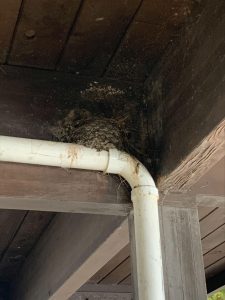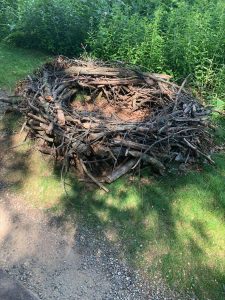Like humans, birds need a place to lie down and rest. Also just like humans, they don’t all prefer a one-story ranch house (although some chimney swifts might). Nests are important for birds not only to provide a home and shelter from predators and the great outdoors, but also they provide a place for these birds to lay their eggs and raise their chicks. These nests range from a woodpecker drilling a hole in a tree, to a swift building a grass nest and sticking it to the side of a cliff with its own saliva! Let’s take a look at some more of these incredible nests in more detail.
The barn swallow builds a mud cup and uses the ability of mud to stick to and then dry on a surface. This mud nest is generally reinforced using various grasses and leaves as many other songbirds would do. Even with all this hard work, due to the threat of predators and parasites, these birds will often make a new nest every year. These beautiful iridescent birds used to nest in caves all around North America; however, they now are more apt to make their homes on human-made structures, hence the “barn” in Barn Swallow.
Make sure to grab your hiking boots and snow pants during the winter, because this is when you will have the most success finding a bird’s nest. Normally nests are well-hidden by birds in the hopes that predators will not find them. However, during the winter when all the leaves have fallen, there is little cover to be found, giving us a direct line of sight to various nests up in the trees. This lack of cover during the winter is not a problem for birds though—without any eggs to incubate they have no need for their nests.
Some birds such as robins make use of our litter and use strings, yarn, hair, and yes even cigarette butts to weave in their nest. It’s even been found that the nicotine in cigarette butts can deter parasites away from the nest. It seems that the concept of reduce, reuse, and recycle has certainly been adopted in the bird community.
Lastly, let’s talk about the sneakiest of the bunch: the nest stealers. Sometimes building these fantastic houses is too much work, so they will take someone else’s nest instead. House sparrows and starlings are notorious nest stealers, often stealing from other cavity nesters. Also, because Great Horned Owls start nesting before hawks, they occasionally can take nests from hawks. Apparently the early bird gets the… nest?
If you want to see more nests, check out The Cornell Lab’s website and bird cams. They work with several different partners who share live footage of birds and their nests.
Joshua Wright joined the Kellogg Bird Sanctuary in July of 2022 and is the Avian Care Support Technician. He is pursuing a Bachelors in General Biology and Environmental Science from Olivet College.



A legacy of conservation; a commitment to sustainability.
Kellogg Bird Sanctuary12685 East C Avenue
Augusta, MI 49012
Phone: (269) 671-2510 birdsanctuary@kbs.msu.edu